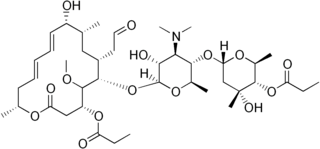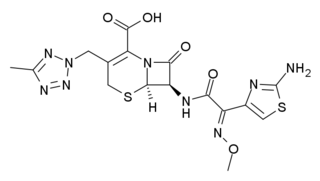
An antibiotic is a type of antimicrobial substance active against bacteria. It is the most important type of antibacterial agent for fighting bacterial infections, and antibiotic medications are widely used in the treatment and prevention of such infections. They may either kill or inhibit the growth of bacteria. A limited number of antibiotics also possess antiprotozoal activity. Antibiotics are not effective against viruses such as the common cold or influenza; drugs which inhibit growth of viruses are termed antiviral drugs or antivirals rather than antibiotics. They are also not effective against fungi; drugs which inhibit growth of fungi are called antifungal drugs.

Antimicrobial resistance (AMR) occurs when microbes evolve mechanisms that protect them from the effects of antimicrobials. All classes of microbes can evolve resistance where the drugs are no longer effective. Fungi evolve antifungal resistance. Viruses evolve antiviral resistance. Protozoa evolve antiprotozoal resistance, and bacteria evolve antibiotic resistance. Together all of these come under the umbrella of antimicrobial resistance. Microbes resistant to multiple antimicrobials are called multidrug resistant (MDR) and are sometimes referred to as a superbugs. Although antimicrobial resistance is a naturally occurring process, it is often the result of improper usage of the drugs and management of the infections.

Hetacillin is a beta-lactam antibiotic that is part of the aminopenicillin family. It is a prodrug and has no antibacterial activity itself, but quickly splits off acetone in the human body to form ampicillin, which is active against a variety of bacteria.

Cefacetrile is a broad-spectrum first generation cephalosporin antibiotic effective in gram-positive and gram-negative bacterial infections. It is a bacteriostatic antibiotic. Cefacetrile is marketed under the trade names Celospor, Celtol, and Cristacef, and as Vetimast for the treatment of mammary infections in lactating cows.

Sitafloxacin is a fluoroquinolone antibiotic that shows promise in the treatment of Buruli ulcer. The molecule was identified by Daiichi Sankyo Co., which brought ofloxacin and levofloxacin to the market. Sitafloxacin is currently marketed in Japan by Daiichi Sankyo under the tradename Gracevit.
Panipenem/betamipron is a carbapenem antibiotic marketed by Daiichi Sankyo Co. of Japan. It was launched in 1993, under the brand name Carbenin.

Josamycin is a macrolide antibiotic. It was isolated by Hamao Umezawa and his colleagues from strains of Streptomyces narbonensis var. josamyceticus var. nova in 1964.

Midecamycin is a macrolide antibiotic that is synthesized from Streptomyces mycarofaciens.

Omoconazole is an azole antifungal drug.

Ribostamycin is an aminoglycoside-aminocyclitol antibiotic isolated from a streptomycete, Streptomyces ribosidificus, originally identified in a soil sample from Tsu City of Mie Prefecture in Japan. It is made up of 3 ring subunits: 2-deoxystreptamine (DOS), neosamine C, and ribose. Ribostamycin, along with other aminoglycosides with the DOS subunit, is an important broad-spectrum antibiotic with important use against human immunodeficiency virus and is considered a critically important antimicrobial by the World Health Organization., Resistance against aminoglycoside antibiotics, such as ribostamycin, is a growing concern. The resistant bacteria contain enzymes that modify the structure through phosphorylation, adenylation, and acetylation and prevent the antibiotic from being able to interact with the bacterial ribosomal RNAs.

Oxolinic acid is a quinolone antibiotic developed in Japan in the 1970s. Dosages 12–20 mg/kg orally administered for five to ten days. The antibiotic works by inhibiting the enzyme DNA gyrase. It also acts as a dopamine reuptake inhibitor and has stimulant effects in mice.

Tosufloxacin is a fluoroquinolone antibiotic. It has a controversial safety profile in relation to other fluoroquinolones. It is associated with severe thrombocytopenia and nephritis, and hepatotoxicity. It is sold in Japan under the brand name Ozex.

Pazufloxacin (INN) is a fluoroquinolone antibiotic. It is sold in Japan under the brand names Pasil and Pazucross.

Cefteram (INN) is a third-generation cephalosporin antibiotic.

Cefuzonam (INN) is a second-generation cephalosporin antibiotic.

Biapenem (INN) is a carbapenem antibiotic. It has in vitro activity against anaerobes. 1-β-methyl-carbapenem antibiotic. Approved in Japan in 2001.
Shionogi & Company, Limited is a Japanese pharmaceutical company best known for developing Crestor. Medical supply and brand name also uses katakana (シオノギ).

Helicobacter cinaedi is a bacterium in the family Helicobacteraceae, Campylobacterales order, Helicobacteraceae family, Helicobacter genus. It was formerly known as Campylobacter cinaedi until molecular analysis published in 1991 led to a major revision of the genus Campylobacter. H. cinaedi is a curved, spiral, or fusiform rod with flagellum at both of its ends which it uses to dart around. The bacterium is a pathogen.

The Journal of Antibiotics is a peer-reviewed medical journal published by the Nature Publishing Group for the Japan Antibiotics Research Association.

















